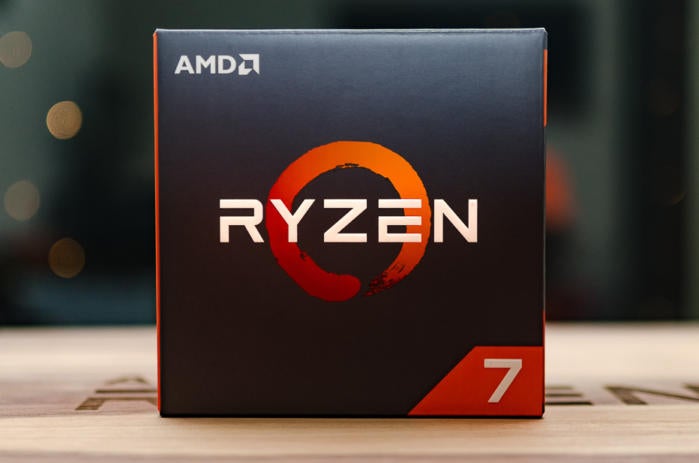AMD’s modern Ryzen APUs with integrated Radeon graphics have been a big hit with budget PC builders since their arrival, and should be in hot demand given the untenable state of today’s graphics card market. But there hasn’t been a fresh DIY offering since the Ryzen 3 3200G’s release in 2019—until now. On Tuesday morning, AMD quietly announced a new generation of Ryzen 5000G desktop processors, including models with significantly more cores than before. You might still be waiting a while to get your hands on one though.
The Ryzen 5000G series—built around the “Cezanne” architecture that debuted in AMD’s excellent Ryzen 5000 Mobile chips—will debut first in prebuilt computers by the likes of Dell and HP before rolling out in DIY retail form later this year, AnandTech and Tom’s Hardware report. Each of the three chips being introduced will come in 65 watt “G” and 35 watt “GE” varieties, with the latter offering lower base clock frequencies:
- Ryzen 7 5700G: 8 cores and 16 threads; 3.8GHz base and 4.6GHz boost clock; 8 Radeon Vega GPU cores at 2GHz.
- Ryzen 5 5600G: 6 cores and 12 threads; 3.9GHz base and 4.4GHz boost clock; 7 Radeon Vega GPU cores at 1.9GHz.
- Ryzen 3 5300G: 4 cores and 8 threads; 4GHz base and 4.2GHz boost clock; 6 Radeon Vega GPU cores at 1.7GHz.
Yes, you’re seeing that right. While all previously available DIY Ryzen APUs topped out at four cores, AMD listened to the loud grumbles for higher-performance options with the Ryzen 5000G series, culminating in the fully loaded 8-core Ryzen 7 5700G. That’s overkill if all your hoping to do is game on the chip’s integrated graphics, but it’s welcome news indeed for people who need modest graphics performance and higher CPU performance for specific tasks. As these aren’t retail chips, however, AMD isn’t announcing pricing just yet.
 Thomas Ryan
Thomas Ryan
There’s a Ryzen 7 version of AMD’s APUs for the first time.
People suffering through the global GPU crisis will be more interested in those Radeon GPU cores, however. The Ryzen 5000G lineup still leans on AMD’s Radeon Vega 8 architecture, rather than the new RDNA 2 architecture found in the Radeon RX 6000-series graphics cards, which you can’t even buy. Still, the company says the Vega 8-based silicon should be much more potent than before. Both the CPU and GPU cores have been built using the 7nm manufacturing process, rather than the 12nm process found in previous chips, which helps unlock much higher frequency for the graphics. The older Ryzen 5 3400G’s Radeon cores topped out at 1.4GHz, but all of the new chips exceed those speeds, with the flagship cranking things up to a blistering 2GHz. That’s wild for integrated graphics.
AMD says that compared against Intel’s Core i7-10700, the new Ryzen 5000G chips are 38 percent faster in content creation, 35 percent faster in productivity, and up to 2.17x faster in gaming, per Tom’s Hardware. Do note that the Core i7-10700 is a last-gen chip that has since been replaced by 11th-gen Core processors with vastly improved Xe integrated graphics performance, however, so we’ll need to see where benchmarks fall whenever these chips become available at retail. (Non-APU Ryzen processors lack integrated graphics entirely.)
It’s also worth noting that AMD stuck with PCIe 3.0 for these APUs, despite the newer Ryzen 4000 and Ryzen 5000 desktop chips migrating to PCIe 4.0. Your ultra-fast PCIe 4.0 SSD will still work in a Ryzen 5000G system, just not at those blistering PCIe 4.0 speeds.
AnandTech is already seeing the Ryzen 5000G offered in a prebuilt system from HP Germany, but more specific details remain scarce, and we aren’t likely to learn firmer price details about DIY retail parts for several months. Nonetheless, we can finally see an oasis at the edge of the desert, and the Ryzen 5000G APUs could once again wind up being a very appealing option indeed for gamers on a budget—especially if this insane GPU crunch continues.
April 13, 2021 at 11:25PM
https://ift.tt/3tgfjal
AMD's new Ryzen 5000G chips wield Radeon graphics and double the cores - PCWorld
https://ift.tt/2RGyUAH
Chips

No comments:
Post a Comment